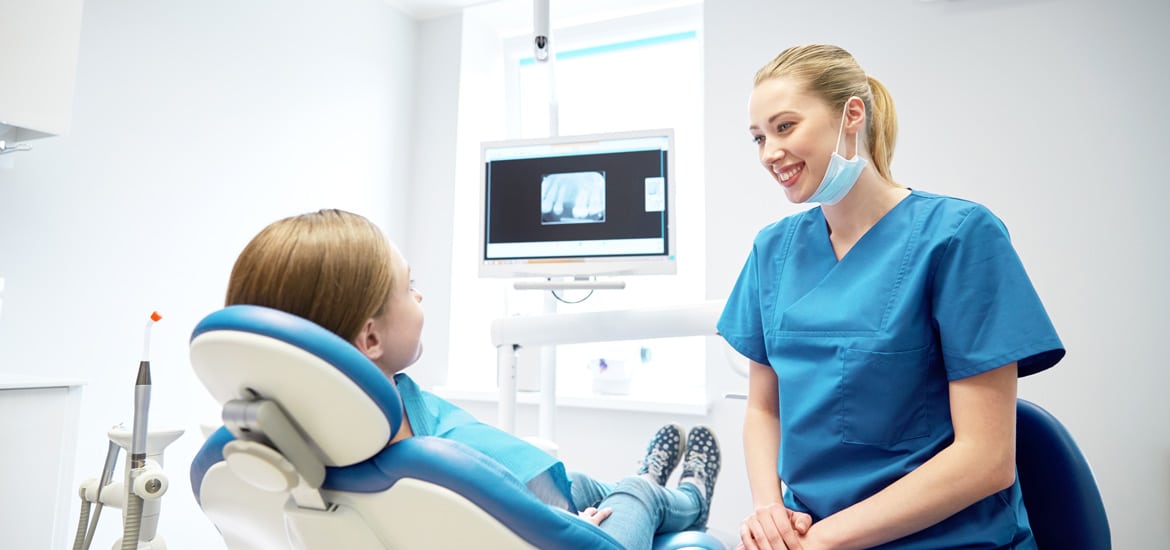Project Description
Periodontal Disease

Periodontal disease is diagnosed by your dentist or dental hygienist during a periodontal examination. This type of exam should always be part of your regular dental check-up.
A periodontal probe (small dental instrument) is gently used to measure the sulcus (pocket or space) between the tooth and the gums. The depth of a healthy sulcus measures three millimeters or less and does not bleed. The periodontal probe helps indicate if pockets are deeper than three millimeters. As periodontal disease progresses, the pockets usually get deeper.
Your dentist or hygienist will use pocket depths, amount of bleeding, inflammation, tooth mobility, etc., to make a diagnosis that will fall into a category below:
Gingivitis
Gingivitis is the first stage of periodontal disease. Plaque and its toxin by-products irritate the gums, making them tender, inflamed, and likely to bleed.
Periodontitis
Plaque hardens into calculus (tartar). As calculus and plaque continue to build up, the gums begin to recede from the teeth. Deeper pockets form between the gums and teeth and become filled with bacteria and pus. The gums become very irritated, inflamed, and bleed easily. Slight to moderate bone loss may be present.
Advanced Periodontitis
The teeth lose more support as the gums, bone, and periodontal ligament continue to be destroyed. Unless treated, the affected teeth will become very loose and may be lost. Generalized moderate to severe bone loss may be present.
It only takes twenty four hours for plaque that is not removed from your teeth to turn into calculus (tartar)! Daily home cleaning helps control plaque and tartar formation, but those hard to reach areas will always need special attention.
Once your periodontal treatment has been completed, your dentist and dental hygienist will recommend that you have regular maintenance cleanings (periodontal cleanings), usually four times a year. At these cleaning appointments, the pocket depths will be carefully checked to ensure that they are healthy. Plaque and calculus that is difficult for you to remove on a daily basis will be removed from above and below the gum line.
In addition to your periodontal cleaning and evaluation, your appointment will usually include:
•Examination of diagnostic x-rays (radiographs): Essential for detection of decay, tumors, cysts, and bone loss.X-rays also help determine tooth and root positions.
•Examination of existing restorations: Check current fillings, crowns, etc.
•Examination of tooth decay: Check all tooth surfaces for decay.
•Oral cancer screening: Check the face, neck, lips, tongue, throat, cheek tissues, and gums for any signs of oral cancer.
•Oral hygiene recommendations: Review and recommend oral hygiene aids as needed. (Electric toothbrushes, special periodontal brushes, fluorides, rinses, etc.)
•Teeth polishing: Remove stain and plaque that is not otherwise removed during tooth brushing and scaling.
Good oral hygiene practices and periodontal cleanings are essential in maintaining dental health and keeping periodontal disease under control!
Periodontal treatment methods depend upon the type and severity of the disease. Your dentist and dental hygienist will evaluate for periodontal disease and recommend the appropriate treatment.
Periodontal disease progresses as the sulcus (pocket or space) between the tooth and gums gets filled with bacteria, plaque, and tartar, causing irritation to the surrounding tissues. When these irritants remain in the pocket space, they can cause damage to the gums and eventually, the bone that supports the teeth!
If the disease is caught in the early stages of gingivitis, and no damage has been done, one to two regular cleanings will be recommended. You will also be given instructions on improving your daily oral hygiene habits and having regular dental cleanings.
If the disease has progressed to more advanced stages, a special periodontal cleaning called scaling and root planing (deep cleaning) will be recommended. It is usually done one quadrant of the mouth at a time while the area is numb. In this procedure, tartar, plaque, and toxins are removed from above and below the gum line (scaling) and rough spots on root surfaces are made smooth (planing). This procedure helps gum tissue to heal and pockets to shrink. Medications, special medicated mouth rinses, and an electric tooth brush may be recommended to help control infection and healing.
If the pockets do not heal after scaling and root planning, periodontal surgery may be needed to reduce pocket depths, making teeth easier to clean. Your dentist may also recommend that you see a Periodontist (specialist of the gums and supporting bone).
Bone Grafting

The success of a dental implant, it’s ability to support a dental restoration, is very much dependent upon how much bone is available in the site where the implant is placed. There are lots of things that affect the bone volume including things like periodontal disease, trauma and infections and it is not unusual to open up a site in the mouth for implant placement and find out that some of the critical supporting bone is missing. No problem…. We have great techniques available to us to replace missing bone. We can increase the height of bone and the width of bone. We can fill in anatomical voids in bone thereby creating new bone and we can fill in all sorts of defects that develop when teeth are lost. We can even use grafting techniques to prevent the loss of bone in circumstances where bone would normally be lost like the extraction of a tooth.
Replacing missing bone or adding to existing bone is very often essential to the success of a dental implant and the ensuing restoration. The techniques to do this are well documented and should be used when indicated by any dentist who places dental implants. Most of us will have a good idea when additional bone or bone repair will be necessary before actually starting the placement of a dental implant and the patients should be informed of this possibility. Sometimes, however, we do get fooled and run into areas where unexpected bone grafting is indicated. As long as the dentist is prepared to replace or add to the existing bone and the patient understands the bone grafting procedure, there should not be any problem with these techniques…
Dental Implants

Dental implants are artificial tooth replacements that were first developed half a century ago by a Swedish scientist named Per-Ingvar Branemark. Implants arose from the patient’s need to secure loose-fitting dentures. Since the advent of the implant, engineering and enhancements to the implant have enabled dentists to expand the implant’s usefulness, including the replacement of missing or lost teeth. Today, implant techniques provide a wide range of tooth replacement solutions including:
•Single Tooth Replacement
•Anterior Replacement
•Posterior Replacement
•Full Upper Replacement
There are three main types of implants:
•The root implant
•The plate form implant
•The subperiosteal implant
The root implant—by far, the most popular—is the most effective because it mirrors the size and shape of a patient’s natural tooth. This implant is often as strong as the patient’s original tooth. The implant or artificial root is placed into the jawbone under local anesthesia, then allowed to heal and integrate with the bone. Once the healing process is completed and the jawbone is attached to the implant, the patient returns to the dental office where the implant is fitted with the new tooth. This process generally takes anywhere from three to eight months.
The plate form implant is ideal in situations where the jawbone is not wide enough to properly support a root implant. The plate form implant is long and thin, unlike the root implant, and anchors into thin jawbones. It is inserted the same way as a root implant. In certain cases, the plate form implant is immediately fitted with the restoration without waiting for the healing process to run its course.
The subperiosteal implant is used when the jawbone has receded to the point where it can no longer support a permanent implant.
What Exactly Does Dental Implant Involve?
First, you will need to discuss your options with your dentist. Together, it will be decided if you are a good candidate for dental implants. The dentist will take a complete dental history, x-rays, and complete a thorough oral examination. If you are a candidate for implant surgery, the procedure is as follows:
•Surgical placement of the implant(s) into the bone. This is usually done right in the dentists office, with a local anesthetic. After surgery, there is a healing period of approximately four months. During this time, the implants fuse to the bone by a process known as osseointegration.
•Next, there is a minor surgical exposure of the top of the implant, whereby the dentist will attach the post to the implant. The function of the post is to become the support for either one tooth or a set of teeth. This is a short procedure that usually requires only local anesthesia.
•The last phase is the restorative phase. The dentist will take impressions and then make a prosthesis that will attach to the implants. This will require several visits. Once completed, your mouth will be restored to natural looking, strong teeth.
Although proper oral hygiene is always recommended for maintaining good dental health, it is especially important when a patient has received a dental implant. Bacteria can attack sensitive areas in the mouth when teeth and gums are not properly cleaned, thus causing gums to swell and jaw bones to gradually recede. Recession of the jawbone will weaken implants and eventually make it necessary for the implant to be removed. Patients are advised to visit their dentists at least twice a year to ensure the health of their teeth and implants. Dental implants can last for decades when given proper care.
Service Request
WHAT OUR PATIENTS SAY
Dr Cruz and her staff are amazing, when you walk in the door you are greeted by the sweetest person, Liz and she is very prompt with scheduling you in when you need an appt or helping you with any questions within her realm.Cindy is Dental Assistant/back office (sorry not sure )? she will always be up front with you when working out the financials. Cindy is also calming and has a warm personality and will always check on you when your in the chair to make sure you are comfortable.
I’m very nervous when it comes to dentistry, but also due to heredity of bad teeth and many bad dentist, but Dr Cruz herself is the sweetest, very professional and has a great bedside manner, she also has a light touch when working on your teeth, so no fear when getting your teeth worked on. She is very patient when working on your teeth.
I am a customer here for more than year. I was waiting for sometime to write a review. I can honestly say that the overall team there is the best.I think they really understand what it takes to maintain the customer. They treat you well. All the staff members are very knowledgeable and polite.
And the most significant positive point is that they will not sell you any service. NO CHEATING or GREEDINESS. They will give you the estimate and work according to your budget. Very Very budget conscious which works great for customers.
If they give you appointment then they will ensure to have you in and start working within 30 mins. Hardly once or twice I have to wait more than one hour. Do not have to wait long.
Had a great experience here. Everyone was very nice and they went out of their way to make me feel comfortable. They took the x-rays and then went over everything with me. They didn’t try and upsell me a bunch of stuff I didn’t need. Great experience.
I continue to have my dental needs taken care of at SmileNOW Dental Group. They are the best! Always professional, welcoming, and with a sense of humor. They make each visit pleasant and they reassure me that my teeth and gums are healthy. I can smile knowing that my smile is a happy one.
